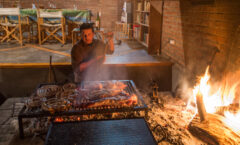
The Panama hat, a fashion item recognised by UNESCO as Intangible Cultural Heritage of Humanity in 2012, is actually handmade in Ecuador following a lengthy and laborious process. The specific skills required are traditionally taught by family members and the precious knowledge is passed down from generation to generation.
- The hats are made out of Toquilla straw, a plant that grows only near the coast of Ecuador, between 100 and 400 meters above sea level. The stalks used for the hats are the new shoots that grow near the base of the plant, which are cut by hand with a machete, bundled up and transported to the weaving villages. Once there, the stalks are opened and the inner leaf fingers are separated and, using a needle, split into dozens of thin straws. The best ones put aside for the hats and those unsuitable are used to make furniture, purses and other items.
- The straws are then bundled up and boiled – timing and temperature are of the essence here - then hung and separated by hand to guarantee an even dry. Once thoroughly dried, the bundles are then placed into an oven with sulfur and charcoal for 24 hours; the smoke will bleach the straw into the pale cream colour associated with the hats.
- The straws then get cut into even lengths ready to begin the weaving process. The first step is the “armado”, the middle center of the hat’s crown. Some “armadores” use wooden blocks, but those with more experience use freehand.
- Next step is the weaver who will create the majority of the hat. And depending on style and quality, this might take months to finish.
- Once the crown and brim are to the correct size, the ‘rematador’ finalizes the process by weaving the straws back into the brim which will prevent the hat from unravelling. This finishing touch is called the ‘remate’, after which the long strands are trimmed.
- ‘Lavado’ is the following stage where the hat is washed, air-dried and once again smoked-bleached with sulfur for 24 hours and then trimmed.
- Then, in order to make the hats look and feel softer, comes the ‘apliado’ where a set of 6 hats are sprinkled with sulfur powder and then beaten up with a wooden mallet
- The penultimate step, ‘planchado’, gives the hat its woven size. It is placed in a wooden block to be shaped, then ironed and a brake line is created using a leather strap to define the brim from the crown.
- Finally there is a precise last trim and the hat is now ready to go.
Tailor-made holidays
Flexible, custom-made holidays to Latin America created to match your exact requirements: our tailor-made itineraries are as unique as the clients for whom they are designed.
Design my tripPapagaio
Your edit for Latin American inspiration
Our exciting range of articles on Latin America explore everything from iconic destinations and lesser-known cultural gems to delicious traditional recipes. You’ll also find exclusive travel tips, first-hand client reviews and the chance to get your personal questions answered by our travel experts.
View Extraordinary Inspiration






































